From internal pipelines, drains are transported by external ...


Surely you paid attention to the roofs of houses, at the very top of which a weather vane is installed. Such a device is a "business card" and even a piece of culture and landscape of most countries. For example, in Tallinn, Riga and Amsterdam, on almost every building you can see a weather vane on the roof. Not everyone knows what it is intended for. It turns out that this is not just a decoration of the house, but also an important attribute with which you can determine the direction and speed of air flows. That is why a weather vane is a necessity, especially in those cities and countries where there is access to the sea.
At present, the windbreaker is more often installed on the roofs of houses as a decoration and a kind of business card. The device may look different. In Dahl’s dictionary one can find such a description: “a weather vane is a small moving flag made of iron that indicates the direction of the wind. Also, the anemone can have a different shape, and is made of another material - tin, in the form of an arrow with a rotating tube. "
Most buildings in famous cities such as Rome and Stockholm are decorated with individual weathercocks. The same can be said of the Kremlin in Moscow. The grace and originality of each weather vane makes us pay attention to the small attributes of buildings. From an ordinary piece of iron you can get a unique item that will not only decorate a cottage, a small house or a summer residence, but also talk about the individuality of the owner.
A device for measuring the direction of the wind is a small flag made of metal, which is fixed on a vertical axis. To determine the strength of the air flow, the weather vane is mounted on a rack that remains movable. In order to know the strength of the wind, it is not necessary to install a weather vane - it can be replaced by a conventional propeller. But now that this small item has become a decoration of the house rather than a necessity, the popularity of the weather vane has increased. He became not only a meteorological instrument, but also a home charm.
The weather vane can have a different shape. Weathercocks in the form of cockerels, a ship or an airplane are popular. Also on the roofs of houses you can find funny frogs, fairy-tale characters and zodiac signs. For example, the weather vane in the form of an angel guards the roof of the famous Peter and Paul Cathedral in St. Petersburg.

You can see interesting weather vane models in the photo:
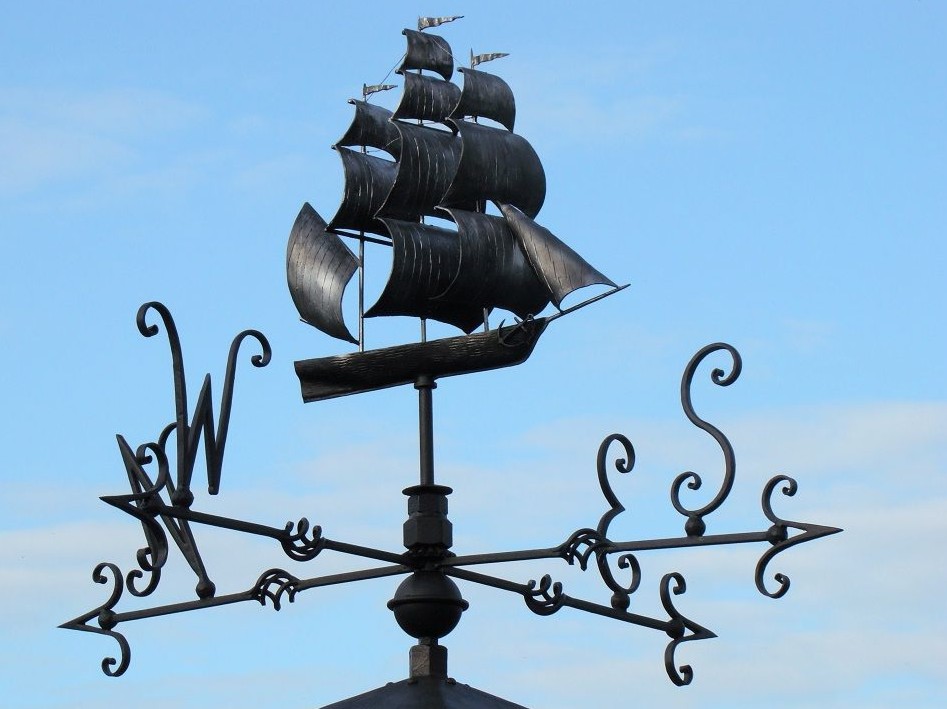

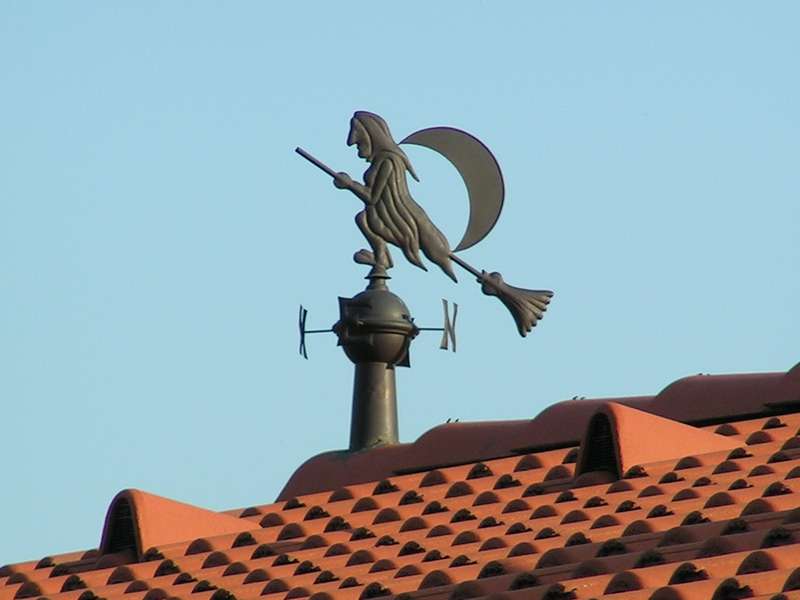
You can purchase a finished weather vane and install it yourself. To do this, you need to prepare everything you need:
How to install a weather vane yourself:
To buy and install a weather vane is half the story. The main thing to observe when installing a small meteorological instrument is that it constantly rotates around its axis. Even if there is a slight wind, the wind vane should still rotate. To achieve this, a bearing must be attached to the weather vane.
If you have a desire to install a weather vane on the roof of your house, but the presented assortment does not satisfy you, then you should make the device yourself. This will be a great chance to emphasize the individuality of the house and make your own, unique weather vane.
You can make the device from sheet steel or from copper. Today you can not puzzle over the size of the weather vane, they have long been standardized. The standard weather vane (upper part) has the following dimensions: 400 mm in height and 800 mm in length. Naturally, if you want to install the device on a small gazebo, garage or fence, then the size can be reduced.
The weather vane has 3 parts:
The weather vane is made according to the drawing. This can be a finished drawing or designed based on drawings and descriptions.
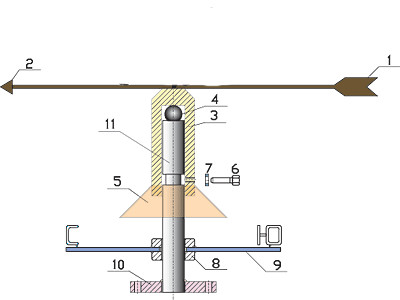
Weather vane can be made of different materials. Several centuries ago, lightweight material, wood, was used to make weathervanes. The most reliable and durable weathervanes are made of metal. Metal figures will last much longer than wooden weathervanes. Even if you make a structure out of plywood soaked with moisture-resistant products and layers of paint, still after several months of “service”, the weather vane may deteriorate. A weather vane made of plywood will not be able to withstand wind and precipitation for a long time, but from a metal - it will last for decades.
You can make a plastic weather vane. This modern material is lightweight and will not corrode, which cannot be said of metal weathercocks. Any part can be obtained from a sheet of plastic, and it can first be designed on a sheet of paper, and then cut according to the finished sample. Some small models of weathercocks can even be made from plastic bottles. Naturally, this option is not suitable for a cottage, but for a cottage in a country house it’s quite.
Real weathercocks made independently of different materials can be met extremely rarely. Basically, such devices are more likely to decorate houses, and they can’t always cope with their direct responsibility - they can’t always show the direction of the wind. You can find massive forged products made by professionals. Such weathercocks are a kind of business card of the owner and indicate his taste and prosperity. It is very difficult to make a forged weather vane on your own, so it is better to dwell on simpler decorative models - from plastic, old discs or sheet of tin. If you decide to make a wooden cockerel on a pole made of plywood, then it is worth covering the figure with paint in several layers, and you need to connect the elements not rigidly. Of course, you can make a weather vane from thick cardboard, but it will last no more than a month. This option is acceptable for children and adolescents, when during the summer holidays a lot of free time and you need to occupy yourself with something.
An interesting model of a weather vane with a propeller:

In order to avoid questions about how to make a weather vane, you need to prepare everything you need in advance, from the drawing, materials, and ending with tools and a suitable place for work. To work, you will need a standard set of carpentry and locksmith tools, which are usually available for every man. If you decide to work with metal, then you need appropriate tools. For plywood or wood, you need to purchase (or rent) a jigsaw, as well as a file and sandpaper. All necessary holes must be drilled in advance with an electric drill. For more serious work with metal parts, you will need a grinder, as well as scissors for metal.
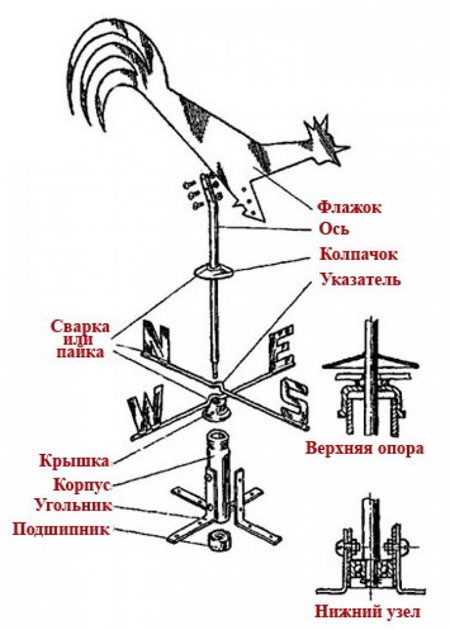
Metal weather vane:

How to make an original weather vane yourself, see this video:
By functional purpose, these devices serve to determine the direction and strength of the wind, which they were originally created from. However, being in the most visible place of the building, weathercocks became noticeable and significant elements of decor, giving the building a unique and original look. The location for them is chosen, as a rule, at the ends of the roof ridge.
Traditionally, these products are made of metal, the most popular is a steel sheet with a thickness of about 2 mm, copper, brass, bronze and other non-ferrous metal products are also used. Drawings for the manufacture of parts are practically unnecessary, the products are simple, and the manufacture is done “in place” An indispensable element of the weather vane is the rod on which it is mounted. It is better to use a bar of stainless steel with a diameter of up to 16 mm, it most sensitive to wind loads and is not susceptible to corrosion.
The objects for displaying the silhouette of the weather vane are very different, you can choose the finished silhouette or plot you like. And often they use pictures of their favorite pets, usually cats or roosters. Often depict angels or demons, in general - the variety is such that it is impossible to list. The size of the figure must be coordinated with the size and shape of the chimney.
Even without artistic skills, you can easily transfer your favorite contour with your own hands along the coordinate grid, then cut it out on paper and use it as a stencil for drawing a picture on metal. Production is reduced to cutting along the contour.
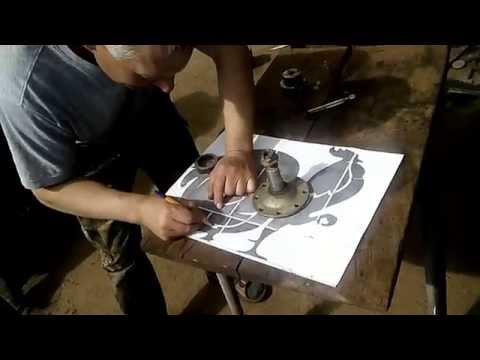
To perform this operation with your own hands, you can use scissors for metal, but with a sheet thickness of 2 mm it will be difficult. It is better to use an electric jigsaw, firmly securing the part to the workbench with clamps. The slotted elements are pre-drilled holes inside such an element of the picture, and then complete the operation with a jigsaw.
Attention! At the end of the work on creating the body of the weather vane, you need to carefully clean the part from burrs and dull the sharp edges, otherwise injuries during further work are inevitable.
To make a vane body with your own hands, you will need tools:
And, of course, you need sheet material of your choice.
The peculiarity of the product is that the windage of the back should be greater than the same indicator for the front of the body of the weather vane, otherwise it will not work. At the same time, a large difference in the weight of the part along the sides of the axis of rotation creates an imbalance of the entire product. In this case, proceed as follows:
Installation of the weather vane is carried out on the rod using a sleeve with a cut under the main part of the product. It is almost impossible to make this part with your own hands at home, you need a lathe. The hole should be located along the axis of the part. Drawings of parts are so simple that they can easily be done with one's own hand.
To facilitate the rotation of the weather vane around its own axis, the design uses a standard ball of bearing installed in the bore of the sleeve.
The weather vane can be mounted in any way convenient for doing it yourself. When installing the volumetric weather vane "Airplane", mounting is best done directly on the stem.
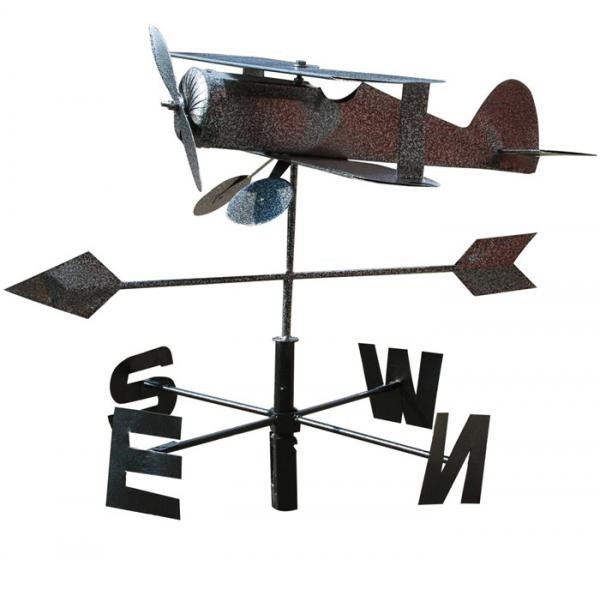
The rod is mounted at the installation site. Stretch marks and a reliable base plate in a shape suitable for the installation site should be considered an obligatory element.
To install the indicators of the cardinal points you need to weld a plate directly under the sleeve on the rod, through which you can install braces. You can determine the location of the cardinal points with the help of a compass during installation of the product at the installation site.
It should be borne in mind that all parts installed using welding must comply with the conditions of weldability, that is, it is impossible to cook a carbon steel part to a stainless steel. The connection will be unreliable.
Still, the use of cold rolled should be recognized as the most acceptable option. steel sheet coated with paint, resistant to environmental influences.
All of the above work must be performed in a workshop.

The photo shows an example of the performance of a weather vane of the “airplane” type with a propeller. Drawings of parts are performed during manufacture depending on the size and installation location.

In the photo is a drawing and model of a weather vane airplane. Based on the specified sizes, drawings of the main parts can be done by yourself. Manufacturing from aluminum and foam.
Attention! Do-it-yourself installation of a weather vane on a chimney or roof ridge is a high-altitude work that requires the implementation of certain safety rules.
Such work cannot be performed:
The chimney or skate of the house, decorated with a beautiful weather vane, acquires a complete design solution, and self-made also aesthetic pleasure from a job well done. Decorate your life and success to you!
In order to know the direction of the wind, its speed and strength in a science such as metrology, a special device is used, shown in the photo, which is called a weather vane. It has the form of a flag, for the manufacture of which various materials are used, including metal. At the opposite end, he has a counterweight. You can make weathercocks with your own hands.
Relatively recently, these devices on buildings were installed by many homeowners, especially in coastal cities, but today they are less in demand. True, in the Baltic republics that were formerly part of the Soviet Union, as well as in the Scandinavian countries and a number of other European states, they can be seen on many roofs of residential buildings and structures for various purposes. Do-it-yourself weathervanes are popular among the population there.
In cities such as Tallinn, Riga, Amsterdam, the weather vane has become a business card. Outstanding local craftsmen have turned the making of a weather vane with their own hands into a real art. So unique in appearance and grace of execution, these products have been adorning the Moscow Kremlin in the Russian capital for several centuries, the building of the city hall in Riga, and in St. Petersburg the spire of the Peter and Paul Cathedral.
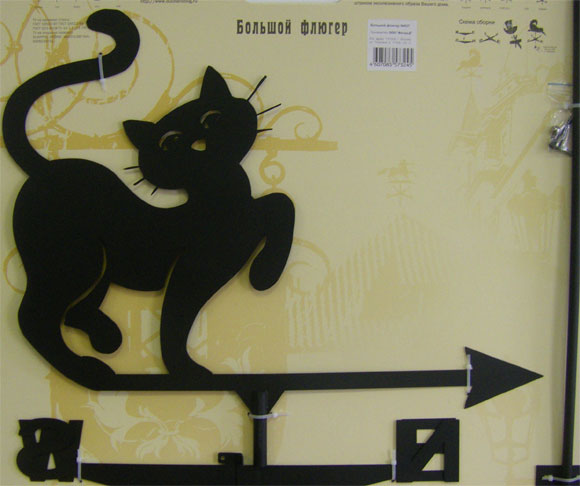
It should be noted that DIY weathercocks have recently become not necessary metrological instruments, but a tribute to national traditions and beautiful toys that can decorate the roof and appearance of the building. From a practical point of view, they are not necessary, because now they use modern devices that show very accurate results.
To decorate the roof of the building and give it an individual style, you can order this product to a professional or make a weather vane with your own hands - drawings for it are available on the Internet and in special literature. Some craftsmen have enough drawing and sketch.
Small items with moving parts are clearly visible on gazebos, garages, greenhouses, and besides, for example, a weather vane with a do-it-yourself propeller, repels birds from garden plots well.
The most common steel or copper pinwheel is a weather vane with their own hands, which is coated with paint for outdoor work. Forged products are less common. Weathercocks made from improvised materials are rare.
Today, many suburban developers give the uniqueness of their home special significance. A distinctive feature becomes a highlight in the exterior of the building. True, there are not many such devices, and one of them is a weather vane. It has long been a popular element in Western Europe, but today you can also find a weather vane on Russian homes, the reason for installing it is to show the direction and strength of the wind.
Currently, manufacturers of various designer gadgets offer a huge assortment of weathercocks made of different materials. It makes no sense to talk about forms and design, the choice is actually the widest. True, such a toy costs a lot of money, so it makes sense to figure out the question of how to make a weather vane from improvised materials with your own hands.
Let's start with the materials, because this device is installed on the roof of the house, it is subject to all known environmental stresses, so you will need to think about its useful life in advance. In principle, do-it-yourself weather vane can be made from anything. Most often there are varieties made of wood (mainly plywood), sheet iron, rarely copper. Although the copper version is considered ideal.

A wooden weather vane, even if it is treated with protective compounds, will last several years. Steel will last several decades if it is periodically tinted, which is not always possible. But copper is an eternal construction. In addition, it is easiest to process a copper sheet, and decorating it will not be a problem.
Many craftsmen have recently cast their eyes on plastic, since there is a free sale of sheet material today. Processing polymer material is simple, for this there is no need to use any complex tools. But such a weather vane can be installed on the roof of the cottage. On a large beautiful house, he simply will not look. Here, expensive materials are needed to match the structure.
As for the tools, they are ordinary, each owner in the barn will have the necessary arsenal. For example, metal scissors, a hacksaw, a saw, a file, sandpaper, a grinder, a drill, a ruler and a pencil.
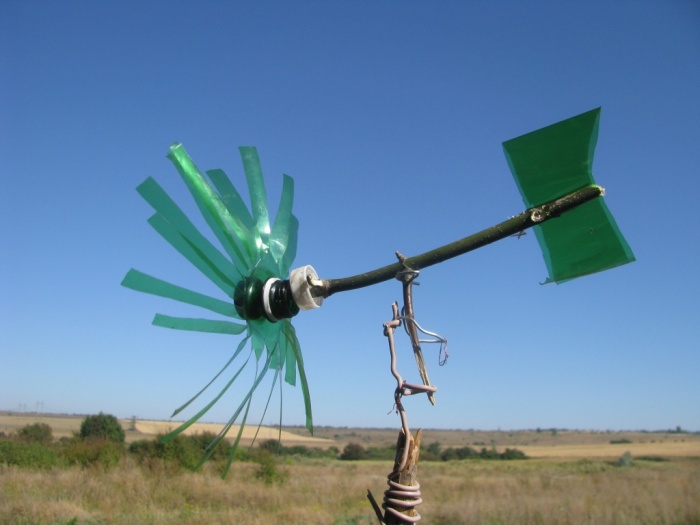
The design of the weather vane is based on two components:
Important! When making a weather vane with your own hands, it is necessary to take into account the moment that the horizontal part should be evenly spaced.

That is, on two sides of the axis should be equal parts by weight. In principle, this is the difficulty of manufacturing.
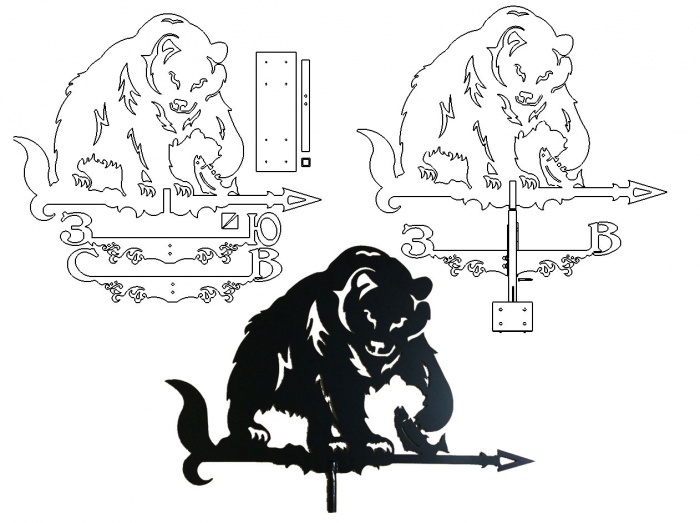
The design features of the weather vane include some additional elements. For example, you can make a weather vane with a screw that will show the strength of the wind. The more intense it spins, the greater the wind force. The design can be supplemented with a vertically mounted plate. It must be fixed in such a way as to remain in a free state. In this case, the plate should swing in one plane. With it, you can also learn about the strength of the wind. The greater the angle of deviation from the vertical, the greater the wind force.
As for the form and design, there are no restrictions. Everything is in your hands, it all depends on imagination and taste preferences. The same applies to the size of the weather vane. True, experts recommend using a width of 40-50 cm, a length of 70-80 cm. For small houses and cottages is the best option. If the weather vane is installed on the roof of the gazebo, then the size can be reduced.
First of all, it is necessary to determine the shape and design of the device. As mentioned above, turn on fantasy. Then your idea should be transferred to paper. The drawing must be done in all the smallest details.

Then you need to make a vertical support with your own hands. To do this, you can use any metal rod: fittings, pipe. Its dimensions: diameter - 13 mm, length 125 mm. In the upper part, a thread is necessarily cut for fastening the horizontal part of the weather vane. You can do it yourself using a die. The process is not very complicated.
A bearing must be installed on the bottom of the weather vane, it is he who will allow the weather vane to rotate around the axis. The decorative element itself is fastened by means of four plates installed at the bottom, which are attached to the metal axis by welding on one side and holes for screws are made on the other side. It is with these fasteners that the weather vane is attached to roofing material at home.
Attention! A very important point is to make sure that water and dirt do not get into the bearing.
Therefore, it is necessary to put on a cap made of metal sheet material when assembling the weather vane. Someone manages to make a cap out of a plastic bottle cap.
![]()
Air vane - the structure is dynamic, so it is not installed on high houses. It just won’t be seen how the propeller turns. Namely, he is the highlight. The complexity of this design is that the rotating part must somehow be freely attached to the figure of the aircraft.
The plane itself can be easily cut with a hacksaw for metal from a sheet of iron, you can make it yourself and from plywood or plastic. But the weather vane propeller must be metallic. It is important to understand that the blades of the rotating element must be located relative to each other at a small angle. The propeller can be cut from a galvanized sheet of iron, which uses metal scissors. In the center of the strip, a hole is made for fasteners. After that, the edges of the strip should be slightly turned in different directions.
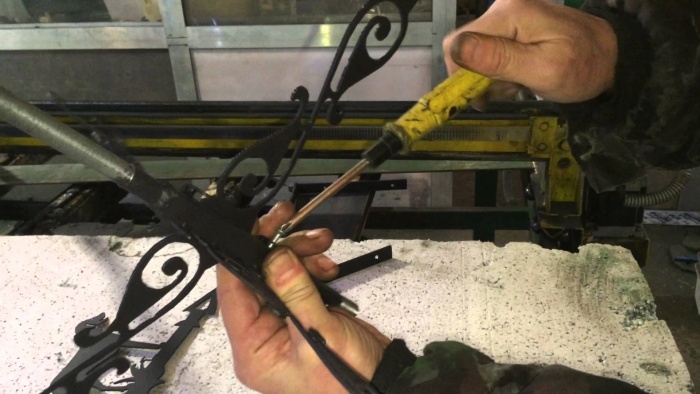
Now you need to fix the propeller to the plane. There are several options:
It is necessary to determine the installation location. It is believed that the weather vane should not spoil the symmetry of the roof structure of the house. Therefore, if there are pipes on the roof, then fastening is best done to them. If there are none, then the best option is the skate of the roof. For installation on the ridge, only two fasteners (strips) are needed, which will be located exactly at the angle of the roof slopes.
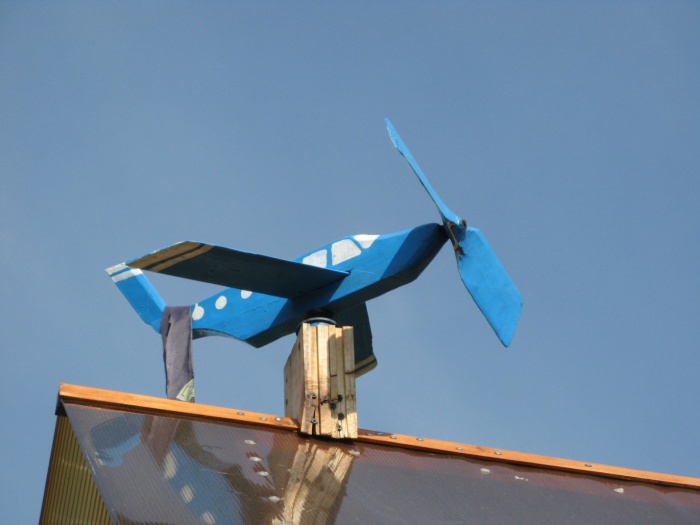
How to assemble the weather vane at the installation site.
By the way, the inner diameter of the pipe is matched to the outer diameter of the bearing. And one more very important point. All parts and units of the weather vane should be performed with a large margin of safety. This is especially true for fixtures. It must withstand sufficiently large wind loads. And the snow will be a great test for him.
Do not forget that the weather vane with a propeller is located in the open. So the rain will wash it constantly. Therefore, it is recommended to lubricate the metal structure with solid oil. And this is after its painting. In addition, periodically it is necessary to tighten the screw assemblies, tint the device, lubricate the bearing, and so on. That is, the weather vane is not just a beautiful element of the exterior design of the house, it is a mechanical toy that must be constantly looked after with your own hands.
It is not enough to make a weather vane with your own hands, you need to correctly install it on the roof. First, the body is stuffed with lithol or solid oil. Then, according to the compass, adjust the direction of the wind rose to the cardinal points.
There are several mounting methods:
To understand that everything is done correctly is quite simple - the product should rotate freely around its axis even in light winds. In this case, you can install a vertical plate on the weather vane, its deviation will show you the strength of the wind. After you have installed the weather vane with your own hands, you can at the same time put a lightning rod. Fix one end of the steel wire to the product, and ground the other one and a half meters.
Now you know how to make a weather vane. So that the device does not fail for a long time, bearings must be lubricated at least once a year.
The most popular decorative form of a product is a rooster. But this does not mean that you should stop at this option. At the moment, you can find drawings for products of completely different shapes. For example, nothing prevents you from making a product in the form of characters from fairy tales, insects, zodiac signs, an airplane, a ship or animals.